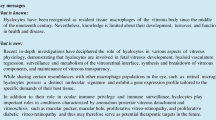Summary
In living vervets, the cells bordering the anterior chamber of the eye were allowed contact for various periods of times (1–40 min) with India ink-, gold- or mercurysulfide particles before fixation. In electronmicrographs the trabecular endothelium cells showed an intense microphagocytic activity, particles were engulfed already after 2–5 min. Various types of free cells (histiocytes, wandering cells etc.) were also found within the trabecular meshwork involved in the process of microphagocytosis. These cells probably originate in the iris tissue or emigrate from the ciliary body. Having engulfed the foreign material in vacuoles of various sizes bordered by a fine membrane, the trabecular endothelial cells change their form and appearance. They often detach tehmselves from the trabecular lamellae and leave the meshwork by way of Schlemm's canal. Cells were found which penetrated with muschroom-like processes through small intercellular stomata in the inner wall of Schlemm's canal (Figs. 18, 19). The trabecular cells are also able to engulf red blood cells or bacteria entirely (Figs. 10, 14). The microphagocytic activity of the inner wall endothelium of Schlemm's canal is low. Sometimes little vacuoles filled with the particles were seen. However in contrast to the trabecular cells no form changes occur within the inner wall endothelium. The particles seem to pass through the cells while the cells remain extended in the row lining the canal (cytopempsis).
Zusammenfassung
Bei Meerkatzen (Cercopithecus aethiops) wurde die Vorderkammer des Auges mit einer Tuscheaufschwemmung bzw. Goldsol- oder Quecksilbersulfidlösung perfundiert. Die Perfusion wurde in verschiedenen Zeitabständen (1–40 min) abgebrochen. Bei der elektronenmikroskopischen Analyse des Trabekelwerkes zeigte sich, daß die Trabekelendothelien schon nach kürzester Kontaktzeit (2–5 min) eineintensive Mikrophagocytoseaktivität entfalten. Die Zellen bilden Fortsätze und Vacuolen verschiedener Größe, die von einer dünnen Membran umgeben sind, aus. Häufig ändern sich Form und Aussehen der Zellen. Sie können sich von den Trabekellamellen ablösen und über den Schlemmschen Kanal in den Kreislauf gelangen. Gelegentlich wurden Zellen beobachtet, die sich gerade durch die Innenwand des Kanals hindurchzwängen. Sie scheinen durch kleine intercelluläre Stomata hindurchgepreßt zu werden oder hindurchzukriechen (Abb. 18
Similar content being viewed by others
References
Amsler, M., F. Verrey etA. Huber: L'Humeur aqueuse et ses fonctions. Paris: Masson & Cie 1955. 397 pp.
Bárány, E. H.: Simultaneous measurement of changing intra-ocular pressure and outflow facility in the vervet monkey by constant pressure infusion. Invest. Ophthal.3, 135 (1964).
Hogan, M. J. andL. E. Zimmerman: Ophthalmic pathology. Philadelphia and London: W. B. Saunders Co. 1964.
Rohen, J. W.: Experimental studies on the trabecular meshwork in primates. Arch. Ophthal.69, 335–349 (1963).
—: Das Auge und seine Hilfsorgane. In Handbuch der mikroskopischen Anatomie des Menschen, begründetv. W. v. Möllendorff, fortgeführt,v. W. Bargmann, Bd. III/4. Berlin-Göttingen-Heidelberg,-New York: Springer 1964.
—, u.H. H. Unger: Feinbau und Reaktionsvermögen des Trabekelwerkes im menschlichen Auge. Anat. Anz.104, 287–297 (1957).
——: Zur Morphologie und Pathologie der Kammerbucht des Auges. Abh. Mainz. Akad. Wiss. u. Lit., math.-nat. Kl., H. 3, Steiner Verlag, Wiesbaden 1959.
Staubesand, J.: Cytopempsis. In: Funktionelle und morphologische Organisation der Zelle, Sekretion und Exkretion, S. 162–189. Berlin-Heidelberg-New York: Springer 1965.
Wittekind, D.: Pinozytose. Naturwissenschaften50, 270–277 (1963).
—, u.G. Rentsch: Quarzphagocytose und Pinocytose im ersten Stadium des Peritonealtests. Silikose-Forsch. S.-Bd. Grundfragen Silikoseforsch.6, 135–154 (1965).
Author information
Authors and Affiliations
Additional information
We would like to dedicate this paper to Professor Dr.K. Goerttler on the occasion of his seventieth birthday.
This work was supported by Research Grant NB-3637 toE. Bárány from the Public Health Service, Bethesda, Md. and by a grant toJ. W. Rohen from the Deutsche Forschungsgemeinschaft, Bad Godesberg.
Rights and permissions
About this article
Cite this article
Rohen, J.W., van der Zypen, E. The phagocytic activity of the trabecular meshwork endothelium. Albrecht von Graefes Arch. Klin. Ophthalmol. 175, 143–160 (1968). https://doi.org/10.1007/BF02385060
Received:
Issue Date:
DOI: https://doi.org/10.1007/BF02385060




